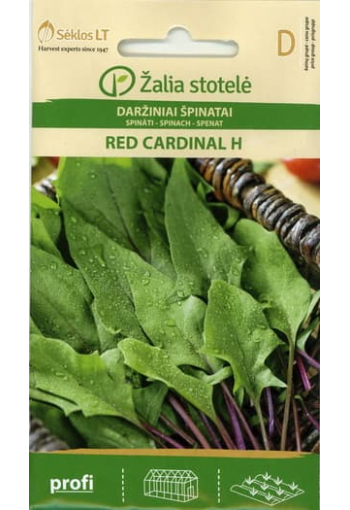Ex Tax: 0.81€
Early hybrid resistant to cucurbit mildew. Cultivated for early spring and autumn harvest.
Vegetation period is 30-40 days from sowing. Leaves are thin, green with reddish veins, pink stem.
Sown in March or September, more densely than other varieties. Used fresh, good for processing.
Spinach leaves are valuable for vitamins, minerals and other nutrients necessary for the body.
* Spinach is a storehouse of vitamins!
A very valuable vegetable annual plant.
It is characterized by a high content of minerals, protein, vitamins.
Spinach contains a large amount of nutrients valuable for the human body. Its leaves contain vitamins C, A, B1, B2, B6, E, D2, PP, P, as well as proteins, phosphorus, calcium and iron salts. In terms of the amount and content of vitamins, spinach significantly surpasses other green and spicy-flavored crops.
Spinach greens have a high dietary value. Its introduction into the diet prevents and cures many diseases of the stomach. Due to its high iron content, spinach is used in the treatment of certain blood disorders.
Spinach is a cold-resistant crop, sown in open ground at the earliest dates, in late April - early May, to a depth of 1.5-2 cm. The culture is demanding on soil fertility and moisture. High temperatures cause shooing, while short days delay leaf development. Therefore, the most optimal sowing is in May - early June. Seeding rate 3-4 g / m2, planting depth 2-3 cm. Row spacing 25-30 cm. Distance between plants after thinning (in the phase of two true leaves) -10 cm.
Harvesting is carried out selectively, repeatedly, before flowering. High summer temperatures force the plant to follow the arrow, so we recommend re-sowing only at the beginning of August (in Estonian climate zone).
Culture is demanding on moisture and soil fertility.
Eng.: Spinach. Suom.: Pinaatti. Sven.: Spenat.
Молодые листья шпината употребляют как сырыми, так и варёными или тушёными, и, конечно, консервированными.
Наиболее полезны, что логично, свежие листья в сыром виде (они довольно хорошо хранятся при температуре +1+2 градуса по Цельсию и не портятся до 3-х месяцев), из них готовят салаты, выжимают сок.
Самые распространённые блюда из шпината - это супы, пюре, а в России - зелёные щи.
Сок шпината является очень полезным диетическим продуктом. Промытый шпинат быстро портится, поэтому мыть его надо непосредственно перед использованием. Шпинат варят в подсоленной воде 7-10 минут. Чтобы при варке шпинат сохранил цвет, его следует варить в открытой посуде в большом количестве воды (3-4 л на 1 кг шпината) при бурном кипении.
Нельзя тушить шпинат вместе со щавелем, так как шпинат при этом изменяет цвет и грубеет.
Сок из шпината является хорошим натуральным красителем: он придаёт блюдам насыщенный зелёный цвет.











